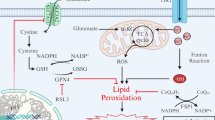Abstract
Neurodegenerative disorders of the central nervous system (CNS) are associated with an increased production of hydrogen peroxide (H2O2), which is an inducer of apoptosis in various cell types including CNS. Previously it was shown that actovegin (deproteinized calf blood hemodialysate) reduces neuronal apoptosis, but the mechanism of its protective action is still poorly understood. The effect of actovegin on the apoptosis of SK-N-SH human neuroblastoma cells was studied in the present work. The role of different intracellular signaling pathways involving mitogen-activated protein kinases was analyzed using selective inhibitors. Our data show that the signaling pathways involving p38 MAPK and PI3K play the key role in the protective effect of actovegin against hydrogen peroxide-induced apoptosis in SK-N-SH cells.
Similar content being viewed by others
References
Thanan R., Oikawa S., Hiraku Y., Ohnishi S., Ma N., Pinlaor S., Yongvanit P., Kawanishi S., Murata M. 2014. Oxidative stress and its significant roles in neurodegenerative diseases and cancer. Int. J. Mol. Sci. 16 (1), 193–217.
Swomley A.M., Förster S., Keeney J.T., Triplett J., Zhang Z., Sultana R., Butterfield D.A. 2014. Abeta, oxidative stress in Alzheimer disease: Evidence based on proteomics studies. Biochim. Biophys. Acta. 1842 (8), 1248–1257.
Pohanka M. 2013. Alzheimer’s disease and oxidative stress: A review. Curr. Med. Chem. 21 (3), 356–364.
Butterfield D.A., Swomley A.M., Sultana R. 2013. Amyloid ß-peptide (1-42)-induced oxidative stress in Alzheimer disease: Importance in disease pathogenesis and progression. Antioxid. Redox Signal. 19 (8), 823–835.
Ezoulin M.J., Ombetta J.E., Dutertre-Catella H., Warnet J.M., Massicot F. 2008. Antioxidative properties of galantamine on neuronal damage induced by hydrogen peroxide in SK-N-SH cells. Neurotoxicology. 29 (2), 270–277.
Saeidnia S., Abdollahi M. 2013. Toxicological and pharmacological concerns on oxidative stress and related diseases. Toxicol. Appl. Pharmacol. 273, 442–455.
Cui W., Li W., Zhao Y., Mak S., Gao Y., Luo J., Zhang H., Liu Y., Carlier P.R., Rong J., Han Y. 2011. Preventing H2O2-induced apoptosis in cerebellar granule neurons by regulating the VEGER-2/Akt signaling pathway using a novel dimeric antiacetylcholinesterase bis(12)hupyridone. Brain Res. 1394, 14–23.
Zhao Z.Y., Luan P., Huang S.X., Xiao S.H., Zhao J., Zhang B., Gu B.B., Pi R.B., Liu J. 2013. Edaravone protects HT22 neurons from H2O2-induced apoptosis by inhibiting the MAPK signaling pathway. CNS Neurosci. Ther. 19 (3), 163–169.
Hyslop P.A., Zhang Z., Pearson D.V., Phebus L.A. 1995. Measurement of striatal H2O2 by microdialysis following global forebrain ischemia and reperfusion in the rat: Correlation with the cytotoxic potential of H2O2 in vitro. Brain Res. 671 (2), 181–186.
Kwon S.H., Hong S.I., Kim J.A., Jung Y.H., Kim S.Y., Kim H.C., Lee S.Y., Jang C.G. 2011. The neuroprotective effects of Lonicera japonica THUNB against hydrogen peroxide-induced apoptosis via phosphorylation of MAPKs and PI3K/Akt in SH-SY5Y cells. Food Chem. Toxicol. 49, 1011–1009.
Filomeni G., Piccirillo S., Rotilio G., Ciriolo M.R. 2012. p38(MAPK) and ERK1/2 dictate cell death/survival response to different pro-oxidant stimuli via p53 and Nrf2 in neuroblastoma cells SH-SY5Y. Biochem. Pharmacol. 83 (10), 1349–1357.
Wang M., Li Y.J., Ding Y., Zhang H.N., Sun T., Zhang K., Yang L., Guo Y.Y., Liu S.B., Zhao M.G., Wu Y.M. 2015. Silibinin prevents autophagic cell death upon oxidative stress in cortical neurons and cerebral ischemia-reperfusion injury. Mol. Neurobiol. Jan 7. [Epub ahead of print]. doi: 10.1007/s12035-014-9062-5.
Machicao F., Muresanu D.F., Hundsberger H., Pflü ger M., Guekht A. 2012. Pleiotropic neuroprotective and metabolic effects of Actovegin’s mode of action. J. Neurol. Sci. 322, 222–227.
Elmlinger M.W., Kriebel M., Ziegler D. 2011. Neuroprotective and anti-oxidative effects of the hemodialysate actovegin on primary rat neurons in vitro. Neuromol. Med. 13, 266–274.
Astashkin E.I., Glezer M.G., Vinokurov M.G., Egorova N.D., Orekhova N.S., Novikova A.N., Grachev S.V., Yurinskaya M.M., Sobolev K.E. 2013. Actovegin reduces the ROS level in blood samples of heart failure patients and diminishes necrosis of SK-N-SH human neuroblastoma cells. Dokl. Biol. Sci. 448, 57–60.
Yurinskaya M.M., Evgenyev M.B., Antonova O.Yu., Vinokurov M.G. 2010. Exogenous heat shock protein HSP70 inhibits the activation of neutrophils under the influence of bacterial pathogens. Dokl. Acad. nauk. 435, 407–410.
Wang X., Hu D., Zhang L., Lian G., Zhao S., Wang C., Yin J., Wu C., Yang J. 2014. Gomisin A inhibits lipopolysaccharide-induced inflammatory responses in N9 microglia via blocking the NF-B/MAPKs pathway. Food Chem. Toxicol. 63, 119–127.
Peng Y., Hu Y., Feng N., Wang L., Wang X. 2011. L-3n-butyl-phthalide alleviates hydrogen peroxideinduced apoptosis by PKC pathway in human neuroblastoma SK-N-SH cells. Naunyn. Schmiedebergs Arch. Pharmacol. 383, 91–99.
Futosi K., Fodor S., Mó csai A. 2013. Neutrophil cell surface receptors and their intracellular signal transduction pathways. Int. Immunopharmacol. 17, 638–650.
Moschou P.N., Roubelakis-Angelakis K.A. 2014. Polyamines and programmed cell death. J. Exp. Bot. 65, 1285–1296.
Kriem B., Sponne I., Fifre A., Malaplate-Armand C., Lozac’h-Pillot K., Koziel V., Yen-Potin F.T., Bihain B., Oster T., Olivier J.L., Pillot T. 2015. Cytosolic phospholipase A2 mediates neuronal apoptosis induced by soluble oligomers of the amyloid-beta peptide. FASEB J. 19, 85–87.
Stoica B.A., Movsesyan V.A., Knoblach S.M., Faden A. 2005. Ceramide induces neuronal apoptosis through mitogen-activated protein kinases and causes release of multiple mitochondrial proteins. Mol. Cell Neurosci. 29, 355–371.
Naetzker S., Hagen N., Echten-Deckert G. 2006. Activation of p38 mitogen-activated protein kinase and partial reactivation of the cell cycle by cis-4-methylsphingosine direct postmitotic neurons towards apoptosis. Genes Cells. 11, 269–279.
Hossain M.S., Ifuku M., Take S., Kawamura J., Miake K., Katafuchi T. 2013. Plasmalogens rescue neuronal cell death through an activation of AKT and ERK survival signaling. PLoS One. 20, (12):e83508. doi: 10.1371/journalpone.0083508. eCollection.
Author information
Authors and Affiliations
Corresponding author
Additional information
Original Russian Text © M.M. Yurinskaya, E.I. Astashkin, S.V. Grachev, M.G. Vinokurov, 2015, published in Biologicheskie Membrany, 2015, Vol. 32, No. 5–6, pp. 455–460.
Rights and permissions
About this article
Cite this article
Yurinskaya, M.M., Astashkin, E.I., Grachev, S.V. et al. Actovegin protects human neuroblastoma cells SK-N-SH from apoptosis induced by hydrogen peroxide through the PI3K and p38 MAPK signaling pathways. Biochem. Moscow Suppl. Ser. A 10, 68–72 (2016). https://doi.org/10.1134/S1990747815050207
Received:
Published:
Issue Date:
DOI: https://doi.org/10.1134/S1990747815050207




